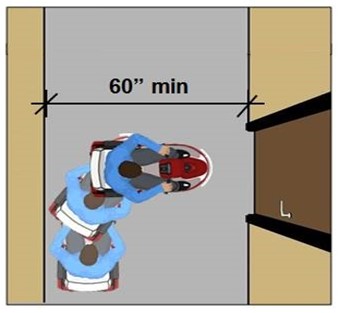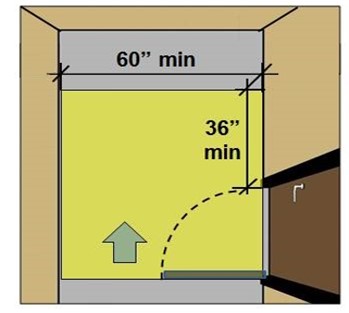Common Questions
Must a primary entrance be accessible?
The Standards require that primary entrances to dwelling units be accessible. It is advisable, though not required, that access be provided to the primary entrances of other types of facilities.
Is there a maximum travel distance to entrances from parking and other site arrival points?
No, the Standards do not limit the travel distance to accessible entrances. Accessible parking spaces must be located on the shortest accessible route to an accessible entrance (relative to other spaces in the parking facility). A quantitative travel distance between entrances and site arrival points is not specified. In addition, accessible routes must coincide with, or be located in the same area as, general circulation paths.
Is automation of doors required?
Automation of doors is not required by the Standards, but it is highly recommended for entrance doors where the opening force is significant. A maximum opening force is not specified for exterior hinged doors because of the closing force typically necessary for ensuring positive latch against wind loading, air pressure, and other conditions. This often results in opening forces well above the 5 lbf maximum. Difficulty opening exterior swing doors is a common complaint. Automation offers the best solution. Otherwise, closers should be set with the minimum force practicable.
Do requirements for “public entrances” apply only to those entrances used by the public?
No, scoping provisions for accessible public entrances are not limited to those used by the public. The term “public entrance” applies to all entrances other than service or restricted entrances. “Restricted entrances” are those available for common use (but not public use) on a controlled basis. This is intended to apply specifically to entrances where user identity is verified and entry is strictly limited to certain occupants, but no one else, including guests or companions of authorized individuals. Other types of entrances with lower levels of security, including employee-only entrances requiring keys, keypads, or access cards, are considered “public entrances.”
Are employee entrances required to be accessible?
Where employee entrances meeting the definition of a “restricted entrance” are provided, at least one must be accessible. Other types of employee entrances must be accessible as “public entrances.” In facilities with separate visitor and employee entrances, access should be dispersed so that accessible entrances serve both types of traffic.
Are doors or gates to employee work areas required to comply?
Areas used only by employees as work areas must provide access for approach, entry, and exit, including means of egress. Entry doors or gates to employee work areas are required to meet applicable requirements, including those for maneuvering clearance, on the exterior, but not the interior. Full compliance of doors or gates on the interior side is recommended, but not required.
Are closet doors and pantry doors required to comply?
Requirements for doors, doorways, and gates in §404 apply to those that provide “user passage” (§206.5). Doors serving walk-in closets or pantries must comply. Doors to shallow closets or pantries, cabinets and other storage elements not providing user passage do not have to comply with provisions for doors, but must meet requirements for storage (§811), including those for clear floor space and operable parts.
Is compliance on both sides of a door or gate required when it is usable only from one side?
No, compliance is not required on both sides of those doors or gates that can be used in one direction only. Compliance is required only on the usable side. Examples include exit-only doors with no operating hardware on the exterior side or separate enter and exit fare gates in transit stations. However, if a door or gate is usable in both directions, even occasionally, such as exit-only doors that may automatically unlock in emergencies to be usable from both directions, then compliance on both sides is required.
Can handrails or other elements overlap door maneuvering clearances?
No, door maneuvering clearances must be free of any overlapping objects, even those providing knee and toe clearance, which can interfere with maneuvering at doors and doorways. However, door maneuvering clearances can be offset up to 8” from the face of the door or gate to accommodate wall thickness, casework, shelves, or other elements adjacent to doorways, including handrails. The door maneuvering clearance must be measured from the leading edge of such elements so that the full clearance is free of any obstruction.
Is latch-side maneuvering clearance as specified in the Standards applicable to doors with panic bars?
When latch-side clearance is required as part of the maneuvering clearances specified for a door, including on the push side of doors with a forward approach that have both a closer and latch, it must be provided at manual doors with panic bars as well. Latch-side clearance not only provides proper positioning at door hardware but also facilitates proceeding through doors against the force of closers.
Are locks operated by keys prohibited due to the pinching or twisting of the wrist their operation typically requires?
No, non-fixed portions of door or gate hardware, including keys and access cards, are not covered by the Standards, but those that can be used without pinching or turning will provide easier access. Non-fixed portions can be modified or adapted as needed for accessibility.
Are spring hinges and gravity hinges considered “closers” in determining the size of maneuvering clearances?
No. Some approaches require additional maneuvering clearances when a door or gate is equipped with a closer because of the additional force that must be counteracted in proceeding through doors. Since spring and gravity hinges do not significantly impact the opening force of doors, they are not considered “closers” for purposes of specifying door maneuvering clearance.
Can maneuvering for a forward approach be provided when there is space at least 60” deep in front of a door?
Space at least 60” deep in front of a door that is unobstructed on approach sides will provide sufficient depth for a forward approach if appropriate strike-side clearance is provided; but in the case of pull-side/ hinge-side approaches, greater latch-side clearance (36” minimum) is still required because the minimum depth for this clearance is 60” (54” if the latch-side clearance is at least 42”).
Space at least 60” deep in front of a door will accommodate a forward approach, except in case of hinge approaches on the pull side.
On the pull side of hinge approaches, 36” min. latch-side clearance is required if the depth is 60” min. (The depth can be 54” min. if the latch-side clearance is at least 42”.)
Is additional latch side clearance required on the push side of doors with a forward approach when either a latch or closer (but not both) is provided?
No, latch clearance 12” minimum is required for forward approaches on the push-side of doors equipped with both a closer and a latch. If a door has a closer but no latch, or a latch and no closer, no additional latch side clearance is required (although providing the clearance is helpful in maneuvering through doors with closers without latches). This is also true for the additional depth required for hinge approaches on the push side when both a closer and latch is provided. For latch approaches, additional clearance is required on the push side and the pull side when just a closer is provided.
Are screen doors or storm doors considered “doors in series”?
No, screen or storm doors are not considered “doors in series” since they are part of the same doorway opening as the entry door. They are not prohibited by the Standards but must meet all applicable requirements for doors except those pertaining to doors in series.
If a more recent edition of ANSI/BHMA Standards for automated doors is issued should that be followed instead of those referenced?
The specific editions of the ANSI/BHMA Standards referenced by the Standards are to be followed (although the Access Board intends to update references to keep them current). Compliance with a later edition may be possible under the provision for “equivalent facilitation” (§103) if it is comparable to, or stricter than, the referenced editions.




User Comments/Questions
Add Comment/Question